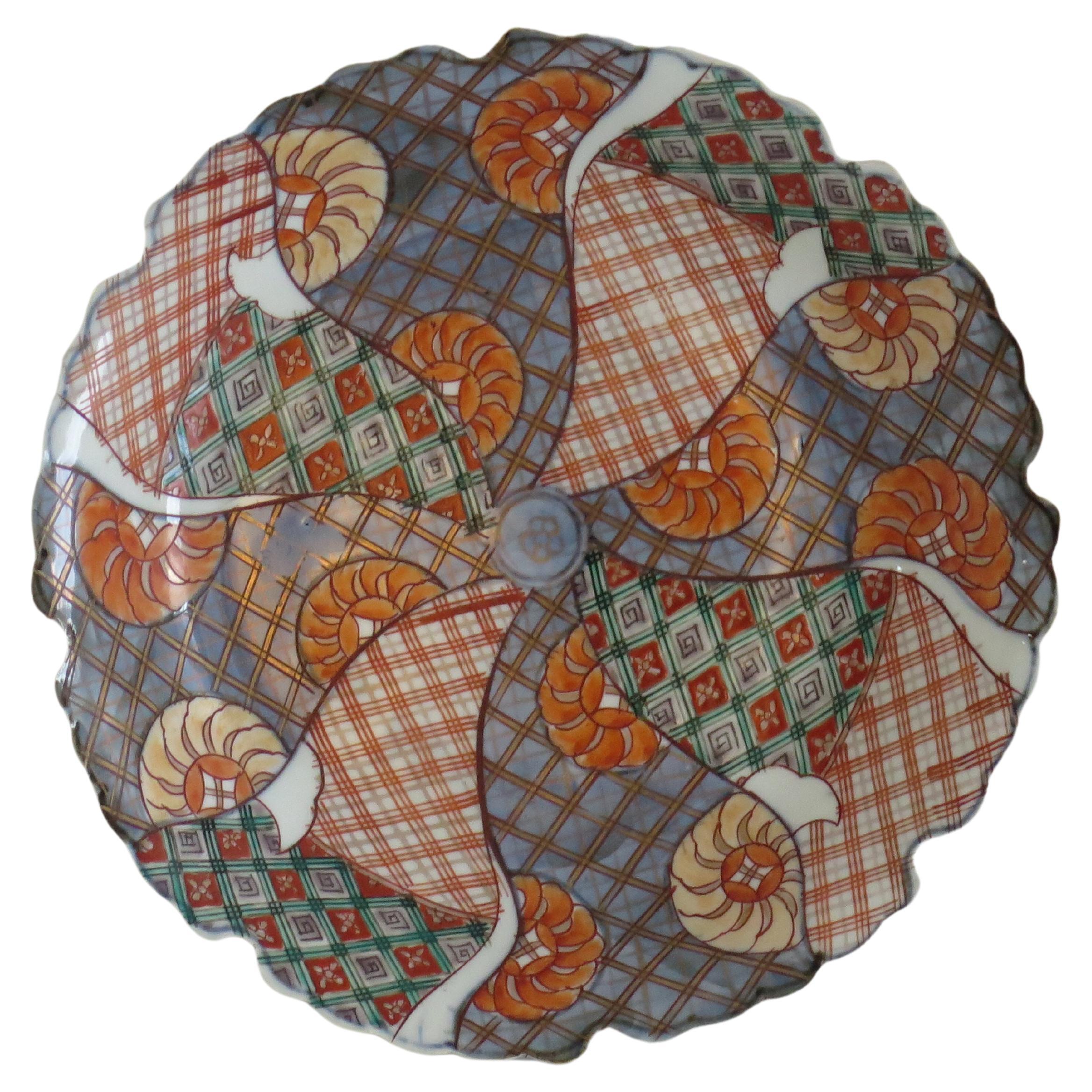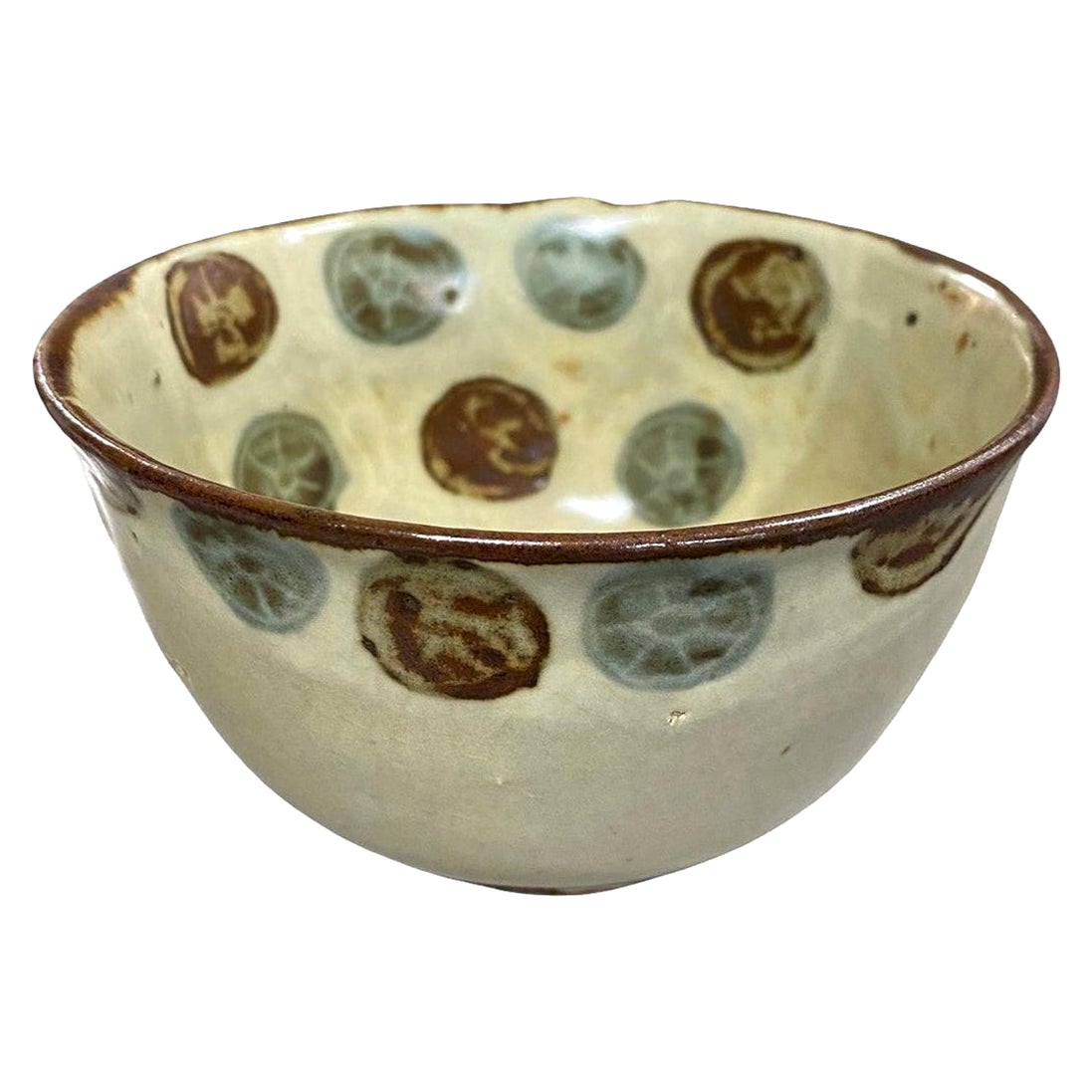Items Similar to Japanese Meiji Period Satsuma Bowl Signed Suizan
Want more images or videos?
Request additional images or videos from the seller
1 of 17
Japanese Meiji Period Satsuma Bowl Signed Suizan
About the Item
Japanese Meiji period satsuma scalloped shaped bowl. The bowl of beautiful form with gilt pin-striping and dotting to the accented areas. The exterior decorated with multiple fish swimming around the outside with small flower sprays between. To the inside a painted netting covers the bowl with butterflies and further floral sprays. The centre decorated with representations of each of the woodcut prints from Hiroshige's Tokaido gojusan tsugi (53 Stations of the Tokaido Road). To the base a stylised cartouche signature within an oval for Suizan.
This Japanese satsuma bowl features rare decoration from Hiroshige's Tokaido gojusan tsugi and would compliment any Japanese collection.
Notes The Fifty-Three Stations of the Tōkaidō (東海道五十三次, Tōkaidō Gojūsan-tsugi), in the Hōeidō edition (1833–1834), is a series of ukiyo-ewoodcut prints created by Utagawa Hiroshige after his first travel along the Tōkaidō in 1832.The Tōkaidō road linked the shōgun's capital Edo to the imperial one Kyōto. It was the main travel and transport artery of old Japan. It is also the most important of the "Five Roads" (Gokaidō). The five major roads of Japan created or developed during the Edo period to further strengthen the control of the central shogunate administration over the whole country.
Measurements (centimetres) 6.5cm High x 19cm Wide
- Dimensions:Height: 2.56 in (6.51 cm)Diameter: 7.48 in (19 cm)
- Style:Meiji (Of the Period)
- Materials and Techniques:
- Place of Origin:
- Period:
- Date of Manufacture:circa 1890
- Condition:Wear consistent with age and use. One pin head size loss to the rim nearly invisible by the naked eye.
- Seller Location:Newark, GB
- Reference Number:
About the Seller
5.0
Vetted Seller
These experienced sellers undergo a comprehensive evaluation by our team of in-house experts.
Established in 2019
1stDibs seller since 2022
Typical response time: 1 hour
- ShippingRetrieving quote...Ships From: Newark, United Kingdom
- Return PolicyA return for this item may be initiated within 14 days of delivery.
More From This SellerView All
- Japanese Meiji Period Satsuma Bowl KinkozanBy KinkozanLocated in Newark, EnglandFrom our Japanese collection, we are delighted to offer this Japanese Meiji period Satsuma Bowl by Kinkozan. The earthenware bowl with pinched rim extensively decorated on both the exterior and interior. The bowl with a cobalt blue base glaze decorated to the borders with gilt shippo-tsunagi (linked-cash) with scattered medallion roundells. Around the exterior two elongated scenes are featured, one with boys playing games in a courtyard with the other featuring seated scholars in full dress both with raised enamel decoration. The interior features a central scene with Samurai warriors in training fully armoured with swords in a courtyard with landscapes scenes to the background. The central scene bordered by further stylised shippo-tsunagi type decoration with a greek key rim border. The bowl signed to the base Kinkozan dating to the Meiji Period (1868-1912) circa 1900. Shippo-Tsunagi (linked-cash) or seven treasures, is a traditional Japanese geometric pattern that combines four ellipses in a circle. These ellipses repeat outward to then create more circles, symbolising eternal peace and happiness. Kinkozan the Kinkozan family have been associated with pottery dating back to 1645. They went on to become the largest producer of Satsuma ware by one individual company, from the end of the 19th century until 1927 after which the factory closed. By the 1850s Kobayashi Sobei (1824-84), Kinkozan Sobei...Category
Antique Early 1900s Japanese Meiji Ceramics
MaterialsCeramic, Earthenware, Pottery, Faux Leather
- Japanese Hand Painted Meiji Period Satsuma VaseBy KinkozanLocated in Newark, EnglandSquat Bulbous Form From our Japanese collection, we are delighted to offer this Japanese Meiji Period Satsuma Vase. The Satsuma vase of squat bulbous form with a tightly pinched nec...Category
Antique Late 19th Century Japanese Meiji Ceramics
MaterialsCeramic, Earthenware, Pottery
- Japanese Meiji Period Satsuma Vase by KinkozanBy KinkozanLocated in Newark, EnglandThe vase is potted in globular form with a tightly pinched neck and rolled top rim beautifully decorated with four highly detailed individual panelled scenes. The first a Geisha bari...Category
Antique Late 19th Century Japanese Meiji Ceramics
MaterialsCeramic, Earthenware, Pottery
- Antique Japanese Meiji Period Satsuma Koro KizanLocated in Newark, EnglandMeiji Period (1868-1912) From our Japanese collection, we are pleased to offer this Antique Japanese Meiji Period Satsuma Koro by Kizan. The Koro of squat bombe form raised upon an...Category
Antique 1890s Japanese Meiji Ceramics
MaterialsCeramic, Earthenware
- Japanese Meiji Period Satsuma Vase Painted by Ryozan for the Yasuda CompanyLocated in Newark, EnglandThe vase of slightly bulbous form potted with a tapered body reaching a slightly pinched neck and rolled top rim is beautifully decorated with two large scenes. The first scene featu...Category
Antique Early 1900s Japanese Meiji Ceramics
MaterialsCeramic, Earthenware, Pottery
- Japanese Satsuma Natsume KinkozanBy KinkozanLocated in Newark, EnglandCobalt Blue Natsume From our Japanese collection, we are delighted to offer this Japanese Satsuma Natsume by Kinkozan. The Natsume of elongated rectangular form with four recessed panels each bordered by a gilt foliage decoration. The Natsume raised upon a square base with a scalloped centre. The top of the Satsuma finished with the original lid with matching gilt foliage decoration. The panels of the Satsuma decorated with multiple figures in various pursuits framed within a shaped recesses. The base of the Satsuma is signed with the Kinkozan mark. The Natsume dates to the Meiji Period (1868-1912) circa 1890. Natsume is a Chaki 茶器 (tea implement) used in a Japanese Tea Ceremony and is a term for a Japanese Tea Caddy...Category
Antique Late 19th Century Japanese Meiji Ceramics
MaterialsEnamel
You May Also Like
- Meiji Period Large Japanese Imari Bowl CenterpieceBy Imari PorcelainLocated in Vero Beach, FLMeiji period large Japanese Imari bowl centerpiece This large, distinctive, octagonal porcelain Imari bowl is painted in rich, inky blue, co...Category
Antique 19th Century Japanese Meiji Ceramics
MaterialsPorcelain
- Japanese Meiji Period Fukagawa Porcelain Charger, circa 1890sLocated in Takarazuka, JPExquisite late 19th century Japanese Fukagawa porcelain charger, circa 1890s, Meiji period (1868-1912).It depicts rocks and auspicious chry...Category
Antique 1890s Japanese Meiji Decorative Dishes and Vide-Poche
MaterialsGold
- Antique Meiji Period Japanese Satsuma Bowl Flowers, 19 CenturyLocated in Amsterdam, Noord HollandFabulous Japanese earthenware Satsuma Bowl depicting flowers. Satsuma Ceramic with mark. Japan – Meiji period (1868-1912) Mark at the base: Bunsei, Japan, Satsuma ware, made by Hoto...Category
Antique 19th Century Japanese Meiji Decorative Bowls
MaterialsPorcelain
- Japanese Meiji Period Gold Cobalt Blue Porcelain Charger, circa 1880Located in Takarazuka, JPExquisite Japanese late-19th century Imari Meiji period (circa 1880) signed porcelain charger in iron-red, cobalt blue and green. It showcases three panels with floral pattern on a dramatic gold background with shishi lions strolling. The panels are set against a stunning cobalt blue background adorned with generous gold details. The three small circles around the rim showcase plum blossom, pine and bamboo patterns, together they create a stunning auspicious “sho-Chiku-bai”. This stunning contrast creates a beautiful scene that invite the viewer to get closer to explore the details. The reverse side is decorated with underglaze cobalt blue hand-painting with the artist signature at the center. The late father of the collector of this exquisite pair, who operated one of the leading kilns in the historic Imari-Arita region of Japan, travelled extensively to Europe in the early 1960s with a mission that he led, to purchase and bring back to Japan antique ceramics...Category
Antique 1880s Japanese Meiji Decorative Dishes and Vide-Poche
MaterialsPorcelain
- Japanese Porcelain Dish or Plate hand painted wheels, Meiji Period circa 1870Located in Lincoln, LincolnshireThis is a good quality and very decorative Japanese porcelain dish or plate, which we date to the Meiji period, circa 1870. The dish is well potted on a low foot with a frilled wav...Category
Antique 19th Century Japanese Meiji Ceramics
MaterialsPorcelain
- Ogata Kenzan Signed Japanese Asian Edo Period Pottery Tea Bowl ChawanLocated in Studio City, CAA spectacularly designed and beautifully made Chawan tea bowl dating back to the Edo period. This work is attributed to Ogata Kenzan who is widely conside...Category
Antique 18th Century Japanese Edo Ceramics
MaterialsPottery





